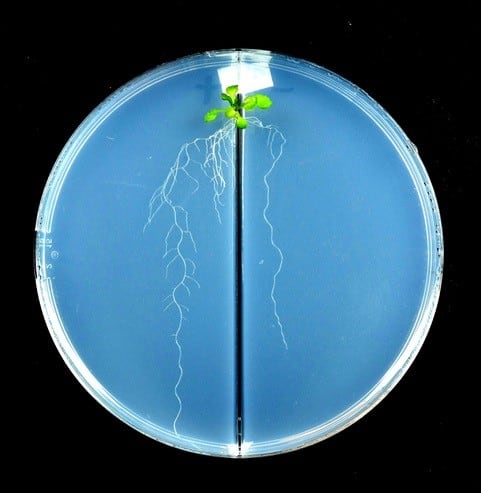2023
GIFS researchers at USask identify protein that helps tell plants ‘no’ when nitrogen is low

Tokizawa’s study shows an Arabidopsis plant root growing in nitrate-sufficient (left) and nitrate-deficient (right) media, with the latter having fewer lateral roots which are critical to help the plant acquire more nitrate in nitrate-rich growth media.
Research led by a post-doctoral fellow at the Global Institute for Food Security (GIFS) at the University of Saskatchewan (USask) is shedding new light into how a protein helps plants acquire nitrogen and other important nutrients for growth.
Dr. Mutsutomo Tokizawa (PhD), a post-doctoral research fellow at GIFS, is the lead author of a new study with Dr. Leon Kochian (PhD), Canada Excellence Research Chair in Global Food Security at USask and research group lead at GIFS. The researchers have identified a novel regulatory mechanism that helps plant roots conserve resources in nitrogen-deficient soils and use them for enhanced growth of the tap root, which can grow deeper into the soil in search of areas with higher concentrations of the nutrient.
The findings support long-term initiatives to develop new crop varieties with root-related traits that help agricultural producers optimize fertilizer applications.
“Nitrogen is the most important nutrient for plant growth, and acquisition of nitrate from roots has a big effect on crop productivity and quality,” said Tokizawa.
“Root architecture is dramatically altered in accordance with changes in soil nitrate concentrations, and one of our goals at GIFS is to develop better roots in crops that contribute to global food security,” said Tokizawa.
Plants absorb more nitrogen than any other nutrient, which is why nitrogen-based products represent the majority of the more than 200 million tons of nitrogen, phosphorus, and potassium fertilizers that are purchased by agricultural producers around the world every year.
Tokizawa’s study, published recently in the Proceedings of the National Academy of Sciences (PNAS), examines how plants respond when nitrate, the primary form in which plants acquire nitrogen-based fertilizers like ammonia or urea, isn’t immediately available.
The project was born in the pandemic: Unable to conduct his expected laboratory work in early 2020, Tokizawa began revisiting data collected from his graduate work at Gifu University in Japan, where he worked in the laboratory that initially identified an interesting protein called STOP1 that had become associated with plant responses to phosphorous and potassium.

Dr. Mutsutomo Tokizawa (PhD) is a post-doctoral research fellow at GIFS.
In the paper, Tokizawa worked with collaborators at Gifu University and other colleagues in Kochian’s Root-Soil-Microbiome Interaction research group at GIFS to conduct a series of experiments in Arabidopsis plants showing STOP1 inhibits the growth of lateral plant roots—which grow from the primary plant tap root—when there is a nitrate deficiency.
The study is the first to note that STOP1 is involved in plant responses to all three major fertilizer nutrients — nitrogen, phosphorus, and potassium — that are required for plant growth.
“It was surprising to see that STOP1 is the protein involved in a number of these interactions, but as we learn more about plants, we are learning how complex they are, especially with regards to plant response to stress,” said Tokizawa, who is to receive the Japanese Society of Soil Science and Plant Nutrition’s Outstanding Young Researcher Award in September.
Tokizawa said the team’s discovery raises several questions for future research. The network of regulators that drive these interactions are extremely complicated and additional work is needed to understand exactly how plants sense an area is low in available nitrate, he explained.
Kochian’s program at GIFS examines the interaction between and among roots, the soil and the microorganisms within the soil that have a substantial effect on soil fertility and crop health. Understanding these interactions is critical to increasing yields and promoting sustainable agricultural systems within challenging—and changing—environments.
“It is clear that roots are still relatively unexplored areas of plant breeding and crop improvement, but they have critical roles to play in improving crop responses to climate change, especially drought and flooding,” said Kochian.
“Bigger roots can also sequester more carbon in the soil. From all of our work, we are finding that increasing root system size can be done without using too much plant carbon also needed for seed yield and this increases nitrogen, phosphorus, and potassium acquisition efficiency. The result is optimized fertilizer inputs and costs to farmers, as well as reduced environmental impact and costs of remediating nitrogen and phosphorus runoff.”
